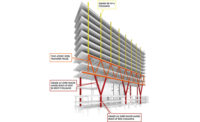Using 80-ksi steel in upper perimeter columns—a first in the U.S.—helped the design team reduce the steel by almost 20% at 320 S. Canal, a 51-floor office tower under construction in Chicago’s Loop. The stronger but smaller elements allowed developer-owner Riverside Investment and Development to offer more open space on upper floors for tenants such as the building’s incoming anchor, BMO.
Architect Goettsch Partners, structural engineer Magnusson Klemencic Associates and steel fabricator Zalk Josephs previously used 70-ksi steel in the perimeter columns of another project in Chicago, 150 N. Riverside, also a first when it was built in 2016. Steel erector Chicago Steel put the first 80-ksi members in place in late October, working for general contractor Clark Construction.
David Tayabji, senior associate with MKA, says the higher-yield-strength steel reduced the total structural steel in the 92,286-sq-ft tower’s columns by almost 20% as well as opening up the upper floors. The 729-ft-tall tower achieves a floor-area ratio of 17 to 11, with setbacks on floors 17, 33 and 49 to offer private terraces. Working with a concrete core, the slender 80-ksi perimeter columns carry the upper structure’s loads to a 65-ksi, belt-truss system from the third to fifth floors, and then on two sides of the building to trusses with three deep V’s that begin on the third floor and transfer the tower’s weight into box columns leading to the building’s footings, and eventually to bedrock.
The trusses with the deep V webs were needed to span an existing sewer line that drains the Eisenhower Expressway interchange and ran directly through the middle of the site until it was relocated. Crews also had to work around and partially remove an abandoned trolley tunnel, directly east of the building’s foundations. There are also active underground rail lines going in and out of Union Station east of the site. Clark placed a portion of the project’s concrete mat working around the sewer line, then completed the mat after the line was moved.
“We actually designed [the upper perimeter columns] as 65 ksi, 70 ksi and 80 ksi and included the three section sizes in construction documents,” Tayabji says. “We had early discussions with fabricators and [structural steel supplier] ArcelorMittal about using 80 ksi, but it wasn’t a done deal until the steel was actually bid.”
New Steel Products
The two steel products that made this possible are ArcelorMittal’s HISTAR/ASTM A913 Grade 80 for the upper perimeter columns and Grade 65 Web Tailor-Made (WTM) steel in the trusses below. This is the first use of HISTAR/ASTM A913 Grade 80 for structural shapes in the U.S.
“The advantage that the 80-ksi steel brought to the project was a higher yield strength, which enabled the project team to shave out some of the weight of the material from the column elements,” says Shelley Finnigan, global technical sales engineer at ArcelorMittal. “Then the WTM material enabled them to create the box sections and to simplify the fabrication of those elements because of the metallurgical characteristics of that material. They were able to customize the section to their stiffness needs.”
Joe Dolinar, a managing partner at Goettsch and the project’s technical partner, adds that with the concrete core handling most of the wind loads, the 80-ksi steel allowed the team to take advantage of “what the market brings in terms of driving the efficiency, driving the cost, all those benefits, rather than using, let’s say, 50-grade steel.” The smaller elements have “added benefits that trickled down,” he says.
Open Feeling
The 65-ksi trusses on the first three floors allowed Goettsch to create an open-feeling, glass-enclosed lobby. They are similar to a project on Chicago’s Riverwalk that Goettsch did with Clark, 110 S. Wacker. On that job, the trusses required three web members coming together where this design required two.
“It was really very few picks to set this whole elevation [of trusses],” says Doug Beilke, assistant superintendent at Clark Construction. “We [installed the deck on] level three and the transfer trusses were three to five picks.” Chicago Steel set the whole belt truss in about two weeks.Tayabji says horizontal W14 steel transfer beams at the top of the belt trusses are rotated on their sides, a suggestion from fabricator Zalk Josephs. That allowed for more efficient connections at the truss panel points.The 80-ksi and 65-ksi sections were cast in ArcelorMittal’s Luxembourg plant and shipped to Zalk Josephs in Janesville, Wis., for detailing and fabrication before going to the site.
With the 80-ksi sections, vs. 50- or even 65-ksi steel, “we went through saw blades and drill bits at a higher pace than we normally do,” says Joseph Lammers, president of Zalk Josephs. “That was really the biggest thing on our side. Working with [80-ksi steel] isn’t hugely different from a welding standpoint.”








Post a comment to this article
Report Abusive Comment